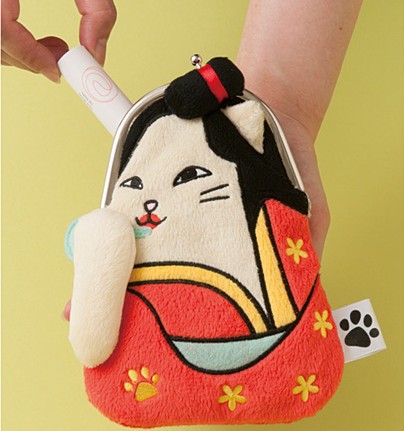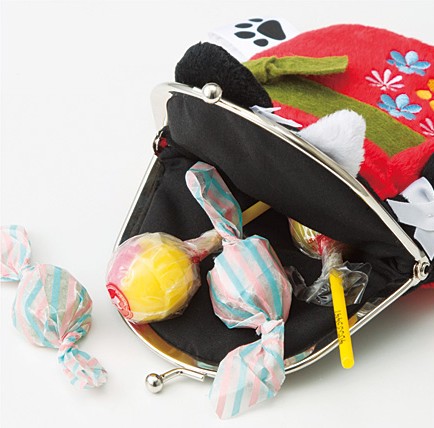
Edo-period artwork gets the cute cat treatment in Japan.
Japanese online retailer Felissimo, which has a whole department dedicated to cat-themed goods, recently added three unusual kittens to their ever-growing collection. Appearing in traditional garb, but retaining feline features, these cats are actually purses taking style cues from famous ukiyo-e woodblock prints from the Edo period (1603 – 1868).
First up, we have a kitty based on a piece called the “Mikaeri Bijin” (Beauty Glancing Back), which was painted by Hishikawa Moronobu (1618-1694), who was known as the “father of ukiyo-e” and mostly painted kabuki scenes and beautiful prostitutes.
Called the “Mikaeri Bineko”, which translates to “Beautiful Cat Glancing Back”, the white hair ties and green obi sash details are dutifully replicated on the clip-top purse. The orange, blue, and white flowers also appear on the red kimono, with the cute addition of a paw print in the design.
Next up, we have a painting from 1794 known as “Otani Oniji III in the Role of the Servant Edobei”, painted by Tōshūsai Sharaku, whose real identity remains a mystery to this day. Active for only ten months between 1794 and 1795, some believe the artist could have been a Noh actor, a little-known poet or perhaps even the famous ukiyo-e master Katsushika Hokusai (c.1760-1849). Despite his short active period, the artist made over 140 prints, mostly of kabuki actors, throwing the public off balance with a realism that often captured the subject’s unflattering details.
However, there’s nothing unflattering about this kitten, especially since he’s showing off a cute, pink paw-pad in the dramatic style of Otani Oniji III. Called “Nyaraku”, a play on words which puts Sharaku, the artist’s name, alongside “nya” an abbreviation of the Japanese word for “meow”, this cat wears stylised kabuki makeup and a cat paw as a family crest.
The last Edo-styled kitten to join the lineup is called “Poppen”. Based on the famous ukiyo-e “Poppen o Fuku Musume” or “Young Lady Blowing on a Poppen” by Kitagawa Utamaro (c.1753-1806), the beauty’s feline doppelgänger wears a big smash of red lipstick and a fancy, red-ribboned top-knot. In her hand, she holds a poppen, a glass bauble toy popular with geisha during the Edo period. When blown at its flat end, the toy would make a popping sound, similar to a whistle.
▼ While the purse can be used to hold coins, its shape makes it more suited to holding small personal items like lip gloss…
▼ …or perhaps even a secret stash of candy.
If you’d like to hold a precious painting with cat features in the palm of your hand, these purses are available online for 2,133 yen each (US$18.20). As always, a portion of the sale price goes to the Felissimo cat fund, which works to care for animals without owners and provide assistance to foster pet programs.
Source and images: Felissimo








 Beautiful ukiyo-e woodblock print artwork appears on three of Japan’s premium beer brands
Beautiful ukiyo-e woodblock print artwork appears on three of Japan’s premium beer brands Amazing ukiyo-e art exhibit gives you the chance to step inside a woodblock print and snap photos
Amazing ukiyo-e art exhibit gives you the chance to step inside a woodblock print and snap photos Mickey Mouse stars in kabuki poses on new line of limited-edition, Tokyo-only goods
Mickey Mouse stars in kabuki poses on new line of limited-edition, Tokyo-only goods Ukiyo-e Heroes: Amazing Nintendo woodblock prints created via traditional, handmade methods【Pics】
Ukiyo-e Heroes: Amazing Nintendo woodblock prints created via traditional, handmade methods【Pics】 Stunning ukiyo-e art experience floats over to Tokyo for its latest exhibition
Stunning ukiyo-e art experience floats over to Tokyo for its latest exhibition Princesses, fruits, and blacksmiths: Study reveals the 30 most unusual family names in Japan
Princesses, fruits, and blacksmiths: Study reveals the 30 most unusual family names in Japan Check out this 8m robot that appeared on Tokyo’s waterfront【Video】
Check out this 8m robot that appeared on Tokyo’s waterfront【Video】 7-Eleven Japan starts new temporary luggage storage service in over 300 branches
7-Eleven Japan starts new temporary luggage storage service in over 300 branches We eat hoya sea squirts out of a can, enjoy a tasty regional delicacy from the comfort of home
We eat hoya sea squirts out of a can, enjoy a tasty regional delicacy from the comfort of home Pizza Hut Japan’s hot lucky bags are perfect for a New Year’s pizza party
Pizza Hut Japan’s hot lucky bags are perfect for a New Year’s pizza party Look stylish while working out on the daily with these crazy geta sandals
Look stylish while working out on the daily with these crazy geta sandals Nakano Broadway sells a fukubukuro lucky bag for foreigners, but is it a good deal or a scam?
Nakano Broadway sells a fukubukuro lucky bag for foreigners, but is it a good deal or a scam? Chiikawa Bakery launches a limited-time menu of sunburned characters and refreshing drinks
Chiikawa Bakery launches a limited-time menu of sunburned characters and refreshing drinks Super-cheap, super-convenient rice-cooking mug is a new kitchen gadget all-star from 3 Coins
Super-cheap, super-convenient rice-cooking mug is a new kitchen gadget all-star from 3 Coins Learn Japanese through ridiculous manga: Two Piece 【Episode #1】
Learn Japanese through ridiculous manga: Two Piece 【Episode #1】 Starbucks Japan ready to get Year of the Horse started with adorable drinkware and plushies【Pics】
Starbucks Japan ready to get Year of the Horse started with adorable drinkware and plushies【Pics】 7-Eleven Japan’s ramen-cooking robot whipped us up a bowl of noodles【Taste test】
7-Eleven Japan’s ramen-cooking robot whipped us up a bowl of noodles【Taste test】 Cyberpunk anime meets traditional culture in Ghost in the Shell gold leaf Japanese changing screens
Cyberpunk anime meets traditional culture in Ghost in the Shell gold leaf Japanese changing screens 7 great places to see Mt. Fuji from without having to climb it
7 great places to see Mt. Fuji from without having to climb it Hello Kitty Choco Egg figures are an adorable trip through three periods of Japanese pop culture【Pics】
Hello Kitty Choco Egg figures are an adorable trip through three periods of Japanese pop culture【Pics】 Japan’s otoshidama tradition of giving kids money at New Year’s gets a social welfare upgrade
Japan’s otoshidama tradition of giving kids money at New Year’s gets a social welfare upgrade We found possibly the quietest Japanese-style hotel in Tokyo’s bustling Shinjuku district
We found possibly the quietest Japanese-style hotel in Tokyo’s bustling Shinjuku district Lacquerware supplier to emperor of Japan and Pokémon team up for new tableware
Lacquerware supplier to emperor of Japan and Pokémon team up for new tableware Sumo Sanrio! Hello Kitty and pals team up with Japan Sumo Association for new merch【Pics】
Sumo Sanrio! Hello Kitty and pals team up with Japan Sumo Association for new merch【Pics】 Can a dirty butthole make you filthy rich in Japan? We’re starting a New Year’s lottery experiment
Can a dirty butthole make you filthy rich in Japan? We’re starting a New Year’s lottery experiment Disillusionment at Tsukiji’s tourist-target prices led us to a great ramen restaurant in Tokyo
Disillusionment at Tsukiji’s tourist-target prices led us to a great ramen restaurant in Tokyo Starbucks teams up with 166-year-old Kyoto doll maker for Year of the Horse decorations【Photos】
Starbucks teams up with 166-year-old Kyoto doll maker for Year of the Horse decorations【Photos】 Tokyo considering law requiring more trash cans following litter increase in heavily touristed area
Tokyo considering law requiring more trash cans following litter increase in heavily touristed area Tokyo’s Tsukiji sushi neighborhood asks tour groups to stay away for the rest of the month
Tokyo’s Tsukiji sushi neighborhood asks tour groups to stay away for the rest of the month Nintendo’s Kirby now delivering orders at Kura Sushi restaurants, but not in Japan
Nintendo’s Kirby now delivering orders at Kura Sushi restaurants, but not in Japan Tokyo event lets you travel back in time, for free, to celebrate 100 years since Showa era start
Tokyo event lets you travel back in time, for free, to celebrate 100 years since Showa era start Sanrio theme park in Japan announces plans to expand into a Sanrio resort
Sanrio theme park in Japan announces plans to expand into a Sanrio resort Japan may add Japanese language proficiency, lifestyle classes to permanent foreign resident requirements
Japan may add Japanese language proficiency, lifestyle classes to permanent foreign resident requirements Survey asks foreign tourists what bothered them in Japan, more than half gave same answer
Survey asks foreign tourists what bothered them in Japan, more than half gave same answer Japan’s human washing machines will go on sale to general public, demos to be held in Tokyo
Japan’s human washing machines will go on sale to general public, demos to be held in Tokyo Japan’s deadliest food claims more victims, but why do people keep eating it for New Year’s?
Japan’s deadliest food claims more victims, but why do people keep eating it for New Year’s? We deeply regret going into this tunnel on our walk in the mountains of Japan
We deeply regret going into this tunnel on our walk in the mountains of Japan Studio Ghibli releases Kodama forest spirits from Princess Mononoke to light up your home
Studio Ghibli releases Kodama forest spirits from Princess Mononoke to light up your home Major Japanese hotel chain says reservations via overseas booking sites may not be valid
Major Japanese hotel chain says reservations via overseas booking sites may not be valid Put sesame oil in your coffee? Japanese maker says it’s the best way to start your day【Taste test】
Put sesame oil in your coffee? Japanese maker says it’s the best way to start your day【Taste test】 No more using real katana for tourism activities, Japan’s National Police Agency says
No more using real katana for tourism activities, Japan’s National Police Agency says Starbucks Japan reveals new sakura drinkware collection, inspired by evening cherry blossoms
Starbucks Japan reveals new sakura drinkware collection, inspired by evening cherry blossoms Updated cherry blossom forecast shows extra-long sakura season for Japan this year
Updated cherry blossom forecast shows extra-long sakura season for Japan this year Japan’s new ukiyo-e woodblock print passports are beautiful, now in travelers’ hands【Photos】
Japan’s new ukiyo-e woodblock print passports are beautiful, now in travelers’ hands【Photos】 Macabre Japanese ukiyo-e reveal gothic side to art of the floating world【Pics】
Macabre Japanese ukiyo-e reveal gothic side to art of the floating world【Pics】 Own the lighter side of ukiyo-e with a zodiac chimera and weird tiger-stone items by Felissimo
Own the lighter side of ukiyo-e with a zodiac chimera and weird tiger-stone items by Felissimo Give your cat culture and class with a beautiful ukiyo-e painting that’s also a scratching post
Give your cat culture and class with a beautiful ukiyo-e painting that’s also a scratching post Video game battles as woodblock prints, “Ukiyo-e Heroes: Boss Fights” now available online 【Pics】
Video game battles as woodblock prints, “Ukiyo-e Heroes: Boss Fights” now available online 【Pics】 Japanese fine art and pill bugs finally become one in BugArts Ukiyo-e series
Japanese fine art and pill bugs finally become one in BugArts Ukiyo-e series Pokémon becomes fine art with series of two hand-crafted Pikachu woodblock prints fans can buy
Pokémon becomes fine art with series of two hand-crafted Pikachu woodblock prints fans can buy Nintendo’s Super Mario Bros. appear as the gods of wind & thunder in new ukiyo-e woodblock print
Nintendo’s Super Mario Bros. appear as the gods of wind & thunder in new ukiyo-e woodblock print These delicate sake glasses decorated with ukiyo-e style cat art are simply delightful
These delicate sake glasses decorated with ukiyo-e style cat art are simply delightful Felissimo releases limited-edition “Color in Edo! Hokusai Colored Pencils” set
Felissimo releases limited-edition “Color in Edo! Hokusai Colored Pencils” set Ukiyo-e woodblock print of vocaloid Hatsune Miku in Edo-period Japan sells out immediately online
Ukiyo-e woodblock print of vocaloid Hatsune Miku in Edo-period Japan sells out immediately online Adorable, whimsical pictures of animals painted by old-school Japanese masters
Adorable, whimsical pictures of animals painted by old-school Japanese masters Tokyo’s beautiful new license plates are based on one of Japan’s most famous woodblock paintings
Tokyo’s beautiful new license plates are based on one of Japan’s most famous woodblock paintings Uniqlo brings cultural cuteness to Edo animals T-shirt line with Japanese history’s greatest artists
Uniqlo brings cultural cuteness to Edo animals T-shirt line with Japanese history’s greatest artists
Leave a Reply